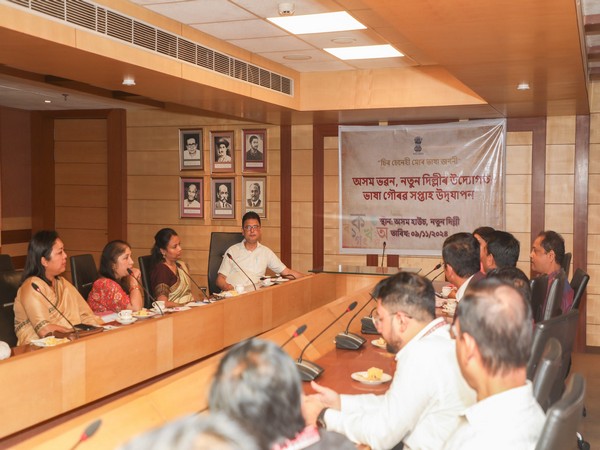The vibrant linguistic heritage of Assam took center stage in Delhi as the much-anticipated Bhaxa Gaurav Saptah (Language Pride Week) concluded with a grand celebration of the state’s rich diversity in language and culture. This annual event, dedicated to promoting and preserving the various languages of Assam, has become a significant platform for showcasing the importance of linguistic identity and cultural pride. The event, held from November 4 to November 10, was marked by a series of cultural programs, discussions, and performances that honored Assam’s contribution to the diverse linguistic landscape of India.
A Week of Celebrations
Bhaxa Gaurav Saptah, initiated by the Assamese community in Delhi, aims to raise awareness about the linguistic traditions of Assam, particularly the Assamese language, which is the state’s official language. The week-long event brings together people from diverse cultural backgrounds and highlights Assam’s unique linguistic tapestry, which includes not only Assamese but also Bodo, Khasi, and other indigenous languages spoken across the state. The celebration serves as a reminder of the importance of linguistic preservation, especially in the face of globalization and the rapid changes in communication brought about by technology.
The grand finale of Bhaxa Gaurav Saptah was marked by a colorful cultural program at the Indira Gandhi National Centre for the Arts (IGNCA), where an array of performances and presentations captured the essence of Assam’s linguistic diversity. The event witnessed a vibrant mix of classical dance, traditional music, folk performances, and literary readings, all reflecting the rich cultural traditions of the state.
Cultural Programs and Performances
The cultural programs, which were a central feature of the event, were a highlight for the audience. Folk songs and dances, especially from the Bihu tradition, resonated throughout the venue, allowing attendees to experience the rhythm and energy of Assam’s most popular dance form. Bihu, known for its lively music and graceful movements, was performed by local artists from Assam, dressed in traditional attire, creating an immersive experience for Delhi’s residents.
Additionally, Assamese classical music and the traditional bajali (a form of folk performance) were performed by talented musicians, showcasing the distinct musical instruments of Assam, such as the dhol (drum), pepa (flute), and gogona (a traditional mouth instrument). The cultural performances were designed not just as entertainment but as a tool for preserving and promoting the linguistic and cultural heritage of Assam.
Literary Discussions and Language Advocacy
In keeping with the theme of linguistic pride, the Bhaxa Gaurav Saptah also featured discussions and panels on the importance of language preservation. These discussions brought together renowned linguists, scholars, and writers from Assam, who spoke about the history of Assamese and other regional languages. The panel discussions emphasized the role of language in shaping identity and its significance in the socio-political landscape of Assam.
One of the key highlights was a discussion on the future of Assamese literature, in which prominent Assamese writers shared their thoughts on how the language has evolved over the years and the challenges it faces in contemporary India. The speakers also touched upon the efforts being made to protect and promote the language, including initiatives in schools, government policies, and the role of the youth in preserving linguistic heritage.
Moreover, a special segment of the event was dedicated to the works of legendary Assamese poets and writers, such as Rudra Mohan Thakur and Mamoni Raisom Goswami, whose contributions to Assamese literature have left an indelible mark on the state’s cultural history. Their poetry, plays, and novels were read aloud by scholars and students, reminding the audience of the enduring legacy of Assamese literature.
Engaging the Younger Generation
A significant portion of the Bhaxa Gaurav Saptah was devoted to engaging younger audiences and students. Schoolchildren and university students participated in poetry recitations, essay writing competitions, and debates, all centered around the themes of language and cultural pride. This initiative aimed at fostering a sense of pride among the younger generation in their linguistic roots and encouraging them to actively participate in the preservation of their heritage.
The event also provided a platform for youth to showcase their skills in modern media, such as film screenings and digital storytelling. Short films made by young filmmakers from Assam, which explored the nuances of the Assamese language and its significance in everyday life, were screened, sparking conversations on the need to incorporate language learning in contemporary formats like digital platforms and social media.
Promoting Unity and Diversity
The Bhaxa Gaurav Saptah not only focused on promoting the Assamese language but also highlighted the cultural diversity of Assam. The state is home to a wide range of ethnic groups and languages, from the Bodos in the western part to the Karbis and Dimasas in the hills, and the Kacharis in the central and southern regions. The event reflected this diversity by celebrating various indigenous languages and their cultural significance, fostering an atmosphere of unity through diversity.
In his closing remarks, the event’s chief guest, a senior government official, commended the Assamese community for their continued efforts in preserving their cultural and linguistic identity. He also emphasized the need for collective action to ensure that the diverse languages of Assam continue to thrive in the face of modernization and urbanization.
Looking Ahead
As Bhaxa Gaurav Saptah concluded, it became clear that the celebration of Assam’s linguistic heritage is not just a one-week affair but an ongoing effort. The event has sparked renewed interest in Assam’s languages and cultures, creating a ripple effect that will likely continue to influence future generations. For the Assamese community in Delhi, it was a moment of reflection and pride, but it also served as a reminder of the work still needed to ensure that the rich linguistic heritage of Assam remains a vital part of the nation’s diverse cultural fabric.




